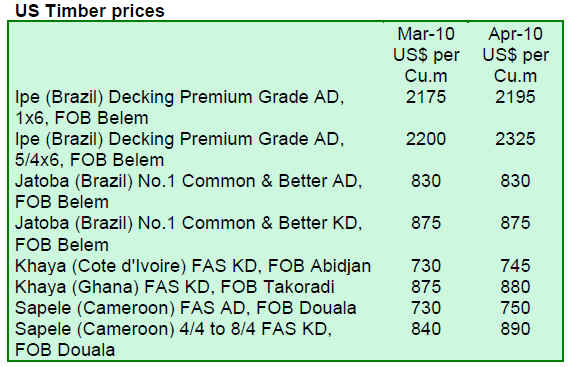|
Report
from
North America
Recovery forecast for housing construction
Growth in employment, low interest rates and stabilising home prices support the recovery of the US housing market, according to the construction forecast conference by the National Association of Home Builders (NAHB). Even though the home buyer tax credit programme ended in April, NAHB forecasts 552,000 single-family housing starts in 2010, up 25% from last year. Total housing starts forecasts range between 700,000 and 750,000 in 2010, and 1 million to 1.2 million in 2011.
Two major factors continue to hold back new construction ¨C the housing surplus from the high number of foreclosures and the shortage of credit for developing and construction. On the other hand, the Federal Reserve will likely continue to keep interest rates near record bottom levels at least through 2010.
The housing market in some regions will recover sooner than in others. According to the conference panellists, the top 20% of the states will be back to normal by the end of 2011. Those states include Texas, Oklahoma, Montana, Wyoming, Tennessee, Louisiana, Mississippi, Alabama and Arkansas and Kansas. The slowest regions to recover include California, Arizona, Nevada, Florida and the Great Lake states.
Lacey Act requires declaration for musical instruments, chairs and hand tools
Importers of wooden chairs, musical instruments, hand tools, sculptures, revolvers and pistols, and other wood products have to declare the scientific name and country of harvest for any wood or other plant material in their products. This latest enforcement phase under the Lacey Act came into effect on 1st April 2010 by the US government.
Other wood product importers have been declaring this information for almost a year, including lumber and flooring importers. The Lacey Act bans the import, export or trade in illegally sourced wood and plant products since 2008. For the complete list of products requiring declaration, visit the US Department of Agriculture¡¯s Animal and Plant Health Inspection Service (APHIS) website: http://www.aphis.usda.gov/plant_health/lacey_act/index.shtml
Canadian forest industry and environmental groups sign world¡¯s largest conservation agreement
The Forest Products Association of Canada reports that 21 of their member companies signed an agreement with nine environmental groups. The so-called ¡®Canadian Boreal Forest Agreement¡¯ covers 72 million hectares of public forests that are licensed to the companies.
The environmental organizations¡¯ goal is to save the woodland caribou, permanently protect vast areas of Canada¡¯s boreal forest and put in place sustainable forestry practices. The ¡°Do Not Buy¡± campaigns by three of the environmental groups will be suspended.
US Timber prices
The participating forestry companies expect a competitive advantage by improving their products¡¯ sustainability. The agreement includes a full life cycle approach to forest carbon management and the recognition of conservation achievements in the global marketplace.
The agreement is established without government¡¯s involvement, but the companies and environmental groups are looking for leadership and participation from all governments, e.g. First Nations, provincial and municipal, to reach the goals of the agreement. AbitibiBowater, Kruger, Weyerhaeuser, ForestEthics, Greenpeace and the Ivey Foundation are among the organizations participating in the agreement.
The US tropical timber imports in first quarter
Balsa lumber imports from Equador were at the same level as in the first quarter last year. Imported volumes of Ipe, Jatoba, Keruing, Red Meranti and Teak were significantly higher compared with the same period in 2009. Acajou d¡¯Afrique lumber from Cote d¡¯Ivoire declined by over 50%, but imports from Ghana and Cameroon were up.
At US$41.7 million imports of hardwood moulding were only slightly above the level of the first quarter last year. Both Jatoba and Ipe moulding imports from Brazil remained below 2009 values at US$5.5 million (-8%) and US$1.2 million (-36%), respectively. Cumaru moulding imports from Peru continued increasing, totaling US$773,000 for the first quarter of 2010. Cumaru imports from Brazil were up from February at US$1.2 million (+13%).
Hardwood flooring imports from Brazil were 48% below the figures in the first quarter 2009, while imports from Malaysia were similar to the same period last year. Flooring exports from Indonesia reached US$195,000 during the first quarter 2010 (+73%). Overall hardwood flooring imports continued to be far below 2009 levels.


Related News:
|